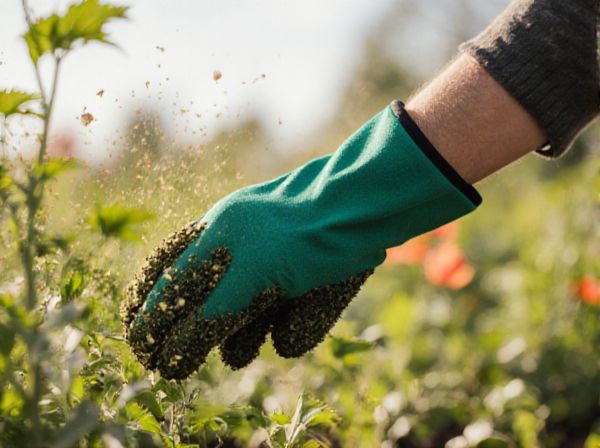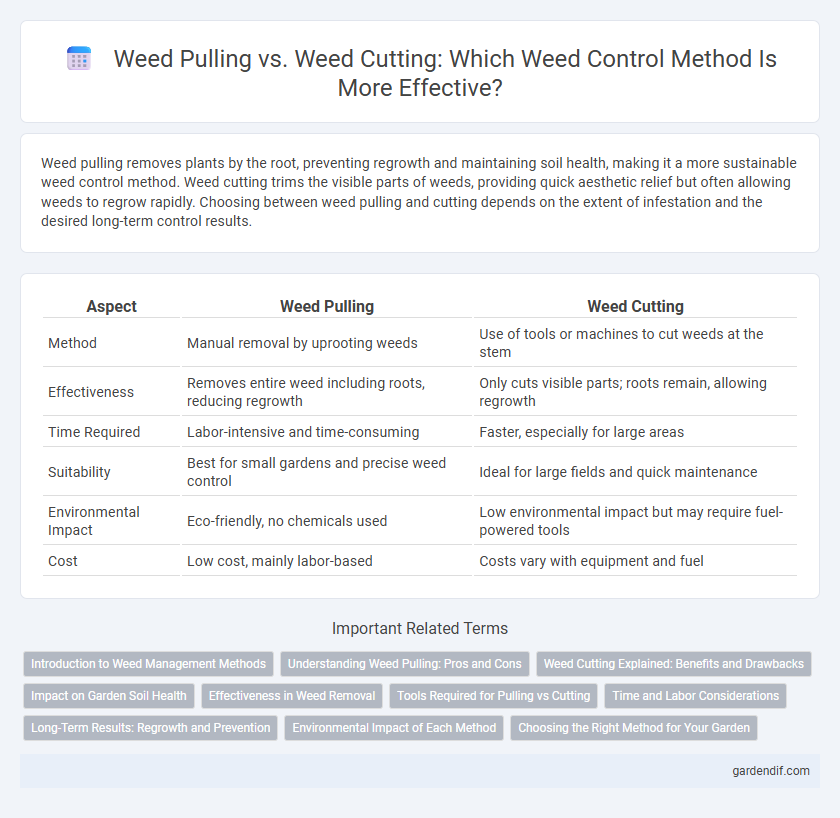
Weed pulling vs weed cutting Illustration
Weed pulling removes plants by the root, preventing regrowth and maintaining soil health, making it a more sustainable weed control method. Weed cutting trims the visible parts of weeds, providing quick aesthetic relief but often allowing weeds to regrow rapidly. Choosing between weed pulling and cutting depends on the extent of infestation and the desired long-term control results.
Table of Comparison
| Aspect | Weed Pulling | Weed Cutting |
|---|---|---|
| Method | Manual removal by uprooting weeds | Use of tools or machines to cut weeds at the stem |
| Effectiveness | Removes entire weed including roots, reducing regrowth | Only cuts visible parts; roots remain, allowing regrowth |
| Time Required | Labor-intensive and time-consuming | Faster, especially for large areas |
| Suitability | Best for small gardens and precise weed control | Ideal for large fields and quick maintenance |
| Environmental Impact | Eco-friendly, no chemicals used | Low environmental impact but may require fuel-powered tools |
| Cost | Low cost, mainly labor-based | Costs vary with equipment and fuel |
Introduction to Weed Management Methods
Weed pulling involves manually removing weeds from the root, offering precise control and minimizing chemical use, which is essential for organic farming and sustainable gardening. Weed cutting employs mechanical tools or machinery to trim weeds at the surface, providing rapid coverage for large areas but often requiring repeated treatments to prevent regrowth. Effective weed management balances these methods based on crop type, field size, and labor availability to optimize weed suppression and promote healthy plant growth.
Understanding Weed Pulling: Pros and Cons
Weed pulling involves manually removing the entire weed, including roots, which prevents regrowth and is environmentally friendly by avoiding herbicides. However, it can be labor-intensive and less effective for large infestations or deep-rooted weeds. Understanding these pros and cons helps in choosing the best weed control method based on garden size and weed type.
Weed Cutting Explained: Benefits and Drawbacks
Weed cutting involves using tools like lawn mowers, string trimmers, or brush cutters to sever weeds at the base, effectively controlling their height and spread without uprooting them. Benefits of weed cutting include quick removal of large weed areas, reduced physical labor compared to hand pulling, and the ability to manage tough or dense vegetation. Drawbacks include potential regrowth from underground roots, the need for frequent repetition to maintain control, and possible disturbance of soil leading to new weed seed germination.
Impact on Garden Soil Health
Weed pulling removes entire roots from garden soil, minimizing regrowth and improving soil aeration, which promotes healthier root development for surrounding plants. In contrast, weed cutting only trims the foliage, leaving roots intact and allowing weeds to regrow rapidly, often leading to soil nutrient competition and reduced soil structure quality. Consistent weed pulling enhances soil microbial activity and organic matter content, supporting long-term soil fertility and plant health.
Effectiveness in Weed Removal
Weed pulling eradicates weeds by the roots, preventing regrowth and offering long-term effectiveness in weed removal. Weed cutting removes only the visible parts, often allowing roots to survive and weeds to reemerge quickly. For sustained weed control, pulling surpasses cutting by targeting the entire plant structure.
Tools Required for Pulling vs Cutting
Weed pulling requires tools such as hand trowels, weed pullers, and gloves designed for grip and root extraction, focusing on removing the entire weed including the root system. In contrast, weed cutting involves tools like string trimmers, hedge shears, or scythes, which slice weeds at the surface level, offering faster clearance but often leaving roots intact. Selecting between pulling and cutting tools depends on weed type, area size, and long-term weed control goals.
Time and Labor Considerations
Weed pulling requires more time and labor due to the need to remove roots manually, ensuring long-term weed control but demanding physical effort. Weed cutting is faster and less labor-intensive, providing immediate visible results but often necessitating frequent repetition since roots remain intact. Choosing between pulling and cutting depends on available labor resources and the desired duration of weed control.
Long-Term Results: Regrowth and Prevention
Weed pulling effectively removes the entire root system, reducing the likelihood of regrowth and promoting long-term weed prevention in gardens and lawns. Weed cutting, while providing a quick aesthetic fix by trimming foliage, often leaves roots intact, resulting in faster regrowth and continued maintenance requirements. For sustainable weed management, combining pulling with appropriate soil treatments enhances long-term control and minimizes future infestations.
Environmental Impact of Each Method
Weed pulling minimizes soil disturbance and preserves beneficial microorganisms, reducing erosion and maintaining soil health, while weed cutting often leads to repeated regrowth and increased use of herbicides. Mechanical pulling decreases chemical runoff that contaminates waterways, promoting biodiversity in both soil and nearby ecosystems. Cutting methods may contribute to higher carbon emissions due to frequent equipment use, exacerbating environmental degradation compared to manual weed removal.
Choosing the Right Method for Your Garden
Selecting between weed pulling and weed cutting depends on garden size, weed type, and desired results. Weed pulling is ideal for removing roots and preventing regrowth, making it effective for deep-rooted or perennial weeds in small areas. Weed cutting quickly controls large infestations or annual weeds by trimming above ground but may require repeated sessions to fully eliminate roots.
Weed pulling vs weed cutting Infographic

 gardendif.com
gardendif.com